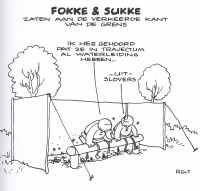"Roman aqueduct"We went to see the aqueduct, the one sightof a surly village near the Pyrenees - surky because there're Cathars? or because they know they've tricked the visitors who write the road-signs and the guide-books. It's not Roman to my eyes - I would swear the man who bled the river Agly at the valley head and planted crops and married local women were Arabs. Straggling back from Poitiers they hid among these hills, remade their home here under fruitful clouds and under dolmens of long-forgotten Franks. Then their pretence saved them, but still they hate the name of Rome. They built the aqueduct, but they dare not say. Alistair Elliot With kind permission of the poet |
 |
Dear Wilke Schram,My very heartiest congratulations on your outstandingly comprehensive website and bibliography on aqueducts. It is a first-rate publication, and I look forward with great interest to your updated version. I offer suggestions, as you request. My chief one is that perhaps you should also include a section on aqueducts in general, as well as the individual sites. This could also include references to ancient sources, notably Vitruvius and Frontinus, as also commentaries on them. It would mean a great deal more work for you, and no doubt you have already considered the possibility, but you will agree, I am sure, that it would also greatly increase the value of your site. [ ...] Of course, a further possible expansion would be to add references not just to the aqueducts proper but to the water distribution system in the towns, with sections on lead pipes, lead poisoning, castella, taps, measuring the quinaria, and so on. The whole water system ought, after all, to be considered as a single entity. In any event, my best wishes for your future success. [ ...] With all good wishes, and warmest congratulations on your work, A. Trevor Hodge (1930 - 2012) Department of Classics, Carleton University, Ottawa e-Mail March 2004 For a biographical notice, see this webpage. |
|
sojourned at the wrong side of the border [Limes] I just heard that the people in Trajectum [Utrecht, NL] already got an aqueduct ...drudgers © rgvt 2007 |
About Roman aqueduct studiesOften the literature about a particular aqueduct looks like a dossier of a prolonged and badly managed court case: testimonies of priests of 200 years ago, contradicted by local fanatics who somewhere have seen a stone which was later lost again, vague maps, weird sketches. Unbelievable; in many cases it is very difficult to make a comprehensive story out of it.In this respect, to document an aqueduct is ten times harder than for example to transform difficult interpretable geological data into a smooth report. Anonymus, November 2008 |
Enjoy!… the Aqua Augusta plays a prominent part [in Pompeii, a novel by Robert Harris]. Not to be confused with the Aqua Augusta in Rome, this is the Serino Aqua Augusta around Naples. The comprehensive page on the Serino with maps and photos is part of Roman Aqueducts, a private website by Wilke Schram of the Netherlands, which has data on a number of Roman aqueducts as well as external links. More links on the author page.An astounding site! Enjoy! Posted by IHahn on the website Roman History Books and more, August 24, 2007 |
| HOME | Last modified: January, 2018 - Wilke D. Schram (W.D.Schram@romanaqueducts.info) |